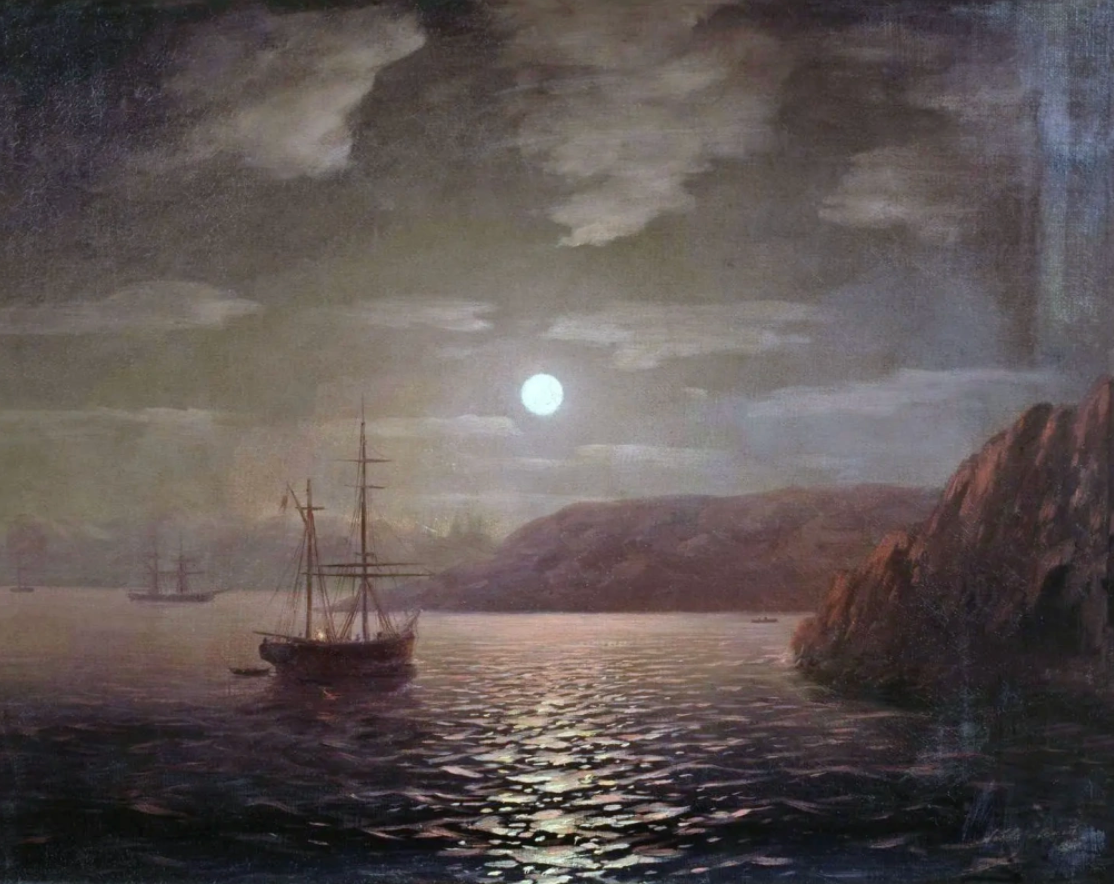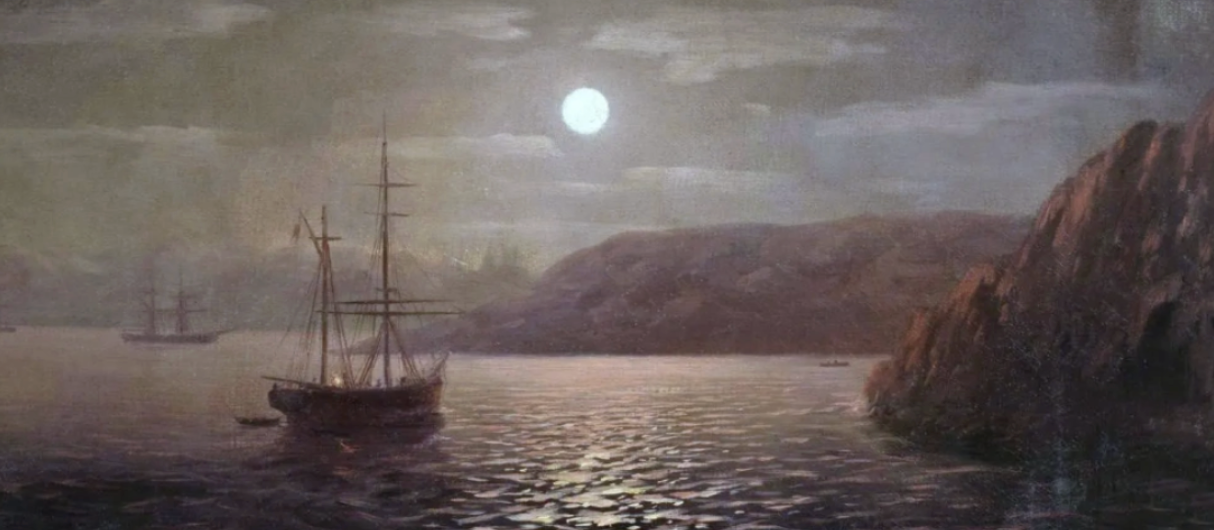Can drunkenness ever be holy? Brady examines the employment of drunkenness as a motif for both spiritual admonition and encouragement in the writings of the Church Fathers and the visual propagation of these teachings through early modern depictions of Noah and His Sons.
Nations have all gone through trials and tribulations in the process of cultivating a distinct identity. The Russian Empire in the nineteenth century was no different, undergoing many transformations, especially following the push by rulers such as Peter the Great and Catherine II in the previous century for a supposed modern and European standard (Taroutina, “Catherine and the 18th Century”). The vast empire was home to people of many different backgrounds and ideologies; Ivan Aivazovsky was one example, as a man of Armenian background who spent time living and working across the empire and throughout Europe. In his lifetime, Aivazovsky would have witnessed the apparent tension that arose between European-centric ideals promoted by Russian elites and the clear diversity of authentic Russian life, resulting in a tension over what constituted Russian national pride. Through his 1859 work, Lunar Night on the Black Sea, Aivazovsky depicts this ambiguity of the nineteenth-century Russian Empire by using a distinct nighttime setting, emphasizing natural elements, and making the main subject, the ships, fit various perspectives.

The nighttime setting in Lunar Night conveys a dim and uncertain mood stemming from the moon’s beams, which direct the viewer through the piece. The full moon is the main source of light. It is low in the sky, illuminating the boats, cliffs, and waves from directly behind. Aivazovsky is able to create a specific tone for the piece by having it set at night. The viewer is set above, looking down onto the water, and there is a clear quietness to the night, with only light waves and minimal action present below. This stillness stimulates a contemplative environment for the viewer, as if they are in the midst of a sleepless night full of thoughts, which may be reflective of Aivazovsky’s own situation while working on this piece. The moon piercing through the night is the main focal point that then leads the eye to the water and the ships. His choice in making this work a landscape painting puts emphasis on objects and their relationship with the environment, instead of on people or actions like a portrait or history painting might. Naturally, a work such as this has more room for interpretation. In all, this choice of setting sets the tone for other themes, and the lighting from the moon creates a road map which the viewer naturally follows to explore further intricacies of the piece.
The setting and scale of the various elements in the painting emphasize humanity’s insignificance to nature, relating to the question of Russia’s apparent size and importance when compared to the rest of the world. Aivazovsky sets this painting in the middle of tall, menacing cliffs. These cliffs are about twice the size of the forward-most ship on the left. They appear quite sharp and detailed. Because the light source is behind the cliffs, they are also dark and intimidating. The water, as well, is almost black in the forward-most left and right corners. These marks make the natural setting strong and fierce. In the far background to the left, there is either a town or more cliffs. Still, the haze in the night sky swallows up these objects, making them incomprehensible to the viewer, showing nature's power to thwart human understanding, leaving the viewer with only guesses as to the identity of what is in the mist.
In the nineteenth century, Russia was a large area, yet other European countries were in many ways still thought to be superior in the realms of art and scholarship (Taroutina, “Picturing the Russian Empire”). As Victoria Charles explains in Ivan Aivazovsky and the Russian Painters of Water, Aivazovsky’s artistic training was rooted in this conception. As the reward for receiving a gold medal at the St. Petersburg Academy of Arts, he was sent abroad to better his skills; he spent time in Italy, France, Holland, and more (Charles 92). It was thought at the time that the finest techniques were used in European art making, in places such as those he visited. There was also a notion in Europe that Russian art had no individuality, and it was viewed as somewhat lackluster. French critic Charles Clement said that Russian artists were “more interested in copying the styles of the masters than creating their own” (Charles 151). Fellow French critic Victor Champier credited the success of Aivazovsky’s work to his studies abroad (Charles 154). The critical opinion of Russian art abroad differed from the inner opinions circulated by the nobility in Russia which would have expressed ideas of national strength. So, when Aivazovsky became the official painter of the Russian Navy after turning down the position of court painter for Tsar Nicholas I, he had the power to depict this dichotomy (Taroutina, “Picturing the Russian Empire”).
The nondescript boats in Lunar Night on the Black Sea suggest a questionable representation of the Russian military, while also leaving their identity open to interpretation. The largest boat has no distinct markings or flags. The sails are down, leaving it a mere skeleton of wooden posts. There seem to be some small people’s heads just above deck, but these people are featureless and also swallowed by the nighttime haze. Additionally, a small light or fire seems to be lit up on deck while a smaller rowboat is located just outside on the left. The ship behind it is even more indistinct. Considering that Aivazovsky was commissioned to do paintings of the Russian Navy, it can be inferred that these are Russian naval ships (Taroutina, “Picturing the Russian Empire”). However, this projects a potential contentious opinion of the Russian Navy. These ships are not portrayed as powerful or imposing and show no real details related to national pride, as one may expect. On the contrary, they are flagless, towered over by the cliffs, and almost invisible without their sails up. One might relate this reluctance to display national pride to Aivazovsky’s background as a man of Armenian descent, born in Crimea, who then lived in various cities across Europe (Charles 81). He seemed to have a complicated relationship with the Russian empire, for example, in the Crimean War, he fought for the protection of Sevastopol, but then worked on art commissions for the enemy Ottoman empire afterwards (Charles 81). This painting was made in 1859, shortly after these events. Aivazovsky had ties to numerous people and places, so the choice of making these boats so nondescript could have been to appeal to multiple perspectives. Furthermore, he seems to express (though the frailness of the boats painted next to the strong cliffs) the inevitable fact that no matter how much humanity may try, nature will always tower over. Similarly, no matter how much effort Russia puts into expressing its strength, it is ultimately uncontrollable, especially considering its insignificance in comparison to the vastness of the world.
Continuing, it is interesting to consider the ways in which these ships could have fit various groups' views. For one, the ships could have appealed to the Tsar, expressing the sentiment that even after the trials of the Crimean War, the navy was still out on the water, there to support the empire. The ships were still standing even though they may have been worn down in battle, which potentially reflects Russian resilience. Also, considering the location of the ships on the Black Sea, it would have been a positive thing in the eyes of Russia to see that their naval powers still had control over parts of this contested area between Russia and the Ottoman Empire. However, this depiction could have also appealed to Russian enemies, reflecting weakness in the Russian Navy through the small stature and bareness of the boats. This duality of interpretations not only appealed to various sides of Aivazovsky’s life, but also potentially gave satisfaction to many different sides of people. Aivazovsky was known to do similar things with works later in his career as well, such as his painting, View of Aul Gunib (1869), which showed the sight where Ter-Gukasov was killed while leading a Tiflis rebellion (Taroutina, “Picturing the Russian Empire”). This work was bought by the Tsar as a testament to Russia’s defeat of Ter-Gukasov, but a copy was also given to the Georgian elites as a representation of their strength against the empire (Taroutina, “Picturing the Russian Empire”). A View of Aul Gunib was made in such a way that it could represent different perspectives and support various sides, as it showed Aivazovsky’s support of Armenian independence while giving him a profit (of multiple thousands of rubles) from Russian elites. A similar situation could have been happening with Lunar Night on the Black Sea, as Aivazovsky depicts these ships in such a way that they could mean many different things depending on the perspective of the viewer.
In conclusion, Ivan Aivazovsky’s Lunar Night on the Black Sea reflects the ambiguity of the Russian Empire at the time of its creation in 1859 through the choice of a nighttime setting, the usage of natural elements, as well as the enigma of the ships. He sets a clear path to follow by having the moon appear in the center, which then guides the eye along its rays to the rest of the mysterious nighttime scene. Through this, the viewer can see the impending natural elements such as the cliffs and dark water, which stimulate thoughts regarding humanity’s relationship with nature and, by extension, Russia’s place in connection to the rest of the world. Additionally, the boats, which are the main subjects in this piece, are quite barren, reflecting Aivazovsky’s own mixed experiences with Russia and leaving them open to interpretation by others based on their own views.
Bibliography
Charles, Victoria. Ivan Aivazovsky and the Russian Painters of Water. New York, USA: Parkstone Press International, 2018.
Taroutina, Maria. "Catherine and the 18th Century." HIAA 1240: Russian and Soviet Art 1757-Present. Lecture, Brown University, Providence, RI, January 30, 2025.
Taroutina, Maria. "Picturing the Russian Empire: Aivazovsky and Orlowski." HIAA 1240: Russian and Soviet Art 1757-Present. Lecture, Brown University, Providence, RI, February 6, 2025.
(Cover Image: Ivan Aivazovsky, Lunar Night on the Black Sea, 1859, oil on canvas, 47 x 58 cm, A. V. Grigoriev Art and History Museum, Kozmodemyansk, Mari El Republic, Russia, via Ivan Aivazovsky Archive)





